

Atrophy is a decrease or absence of development of a body structure or part. In the dental sector, it is about the loss of bone due to the absence of teeth, which makes it impossible to wear implants and fixed prostheses. Bone atrophy can be localized in a specific area or be generalized in both the maxilla and the mandible.
Temporomandibular Joint : What is TMJ ?
The temporomandibular joint is the one that allows us to perform all the masticatory movements: lateral, ascent and descent, protrusion, and retrusion.
TMJ disorders are problems that affect the joints and chewing muscles that connect the lower jaw to the skull.
How to relieve TMJ pain
- You can perform massages both inside and outside the mouth
- Palpation. You can apply pressure with your fingers to certain points of the jaw and face
- Cold spray and muscle stretching. It is done to relax the muscles
- Anesthetic. Can relieve pain
Types of alterations
- Myofascial Pain: May appear in patients with a normal temporomandibular joint
- Internal asymmetry
- Degenerative and inflammatory disorders
What are the causes of these disorders?
Pain can appear from a combination of factors:
- Congenital and developmental disorders: resulting in aplasias, hypoplasia, and hyperlasia
- Muscle problems, headaches, and over time, jaw dysfunctions
- Disorder of the condyle-disc complex
- Metabolic diseases
- Infections
- Condylar subluxation
- Neurological pathologies
- Muscle disorders
- Tooth loss
- Trauma
- Neoplasms
- Osteoarthritis
- Disc-condylar and disc-fossa adhesions
- Ankylosis
- Physical overload
- Stress or depression
- Inflammatory disorders
What are the symptoms?
- Pain in the face, jaw, or neck
- Pain around, in front, or in the ear
- Pain on both sides of the head
- Pain on one side of the head that can be triggered when you clench your teeth
- Pain in the muscles and / or joint of the jaw
- Limited movement or lock of the jaw
- Difficulty or discomfort chewing
- A change in the way the teeth fit together
- Muscle spasms around the jaw
- Difficulty or discomfort chewing
- A change in the way the teeth fit together
- Muscle spasms around the jaw
Specialized TMJ treatments
Each patient will be affected in a different way by the TMJ, your dentist or specialist will assess what the needs of each patient are to diagnose the treatment that best suits them. Jaw pain can go away with little or even no treatment. In the case of needing any treatment, you can go through the application of simple practices such as applying ice or eating soft foods. On the other hand, it may also require the use of pain relievers or devices to be placed in the mouth.
The specialist will always assess the situation of each patient in order to accurately recommend the application of treatments that will be required:
- Conservative treatments:
- Stabilization splints: They reduce activity by modifying sensory stimulation, thus reducing muscle pain caused by constant pressure on the jaw.
- Physiotherapy: favors the quality of life of patients
- Surgical treatments
- Arthrocentesis: A so-called joint lavage is performed through two intra-articular needles, where all microscopic particles are removed and a solution is injected that helps lubricate the joint.
- Arthroscopy: With an intra-articular camera (arthroscope) the joint can be examined, inflammatory tissue removed, and structures manipulated.
- Joint replacement. In the event of functional disability, replacement with an artificial prosthesis is suggested.
- Open Surgery: In the event of a tumor in the joint, open surgery will be required so that the specialist can remove the damaged tissue.
- Tune in to Dr. Pascal TarJanian’s blog for more helpful and educative information about dental health and treatments.

